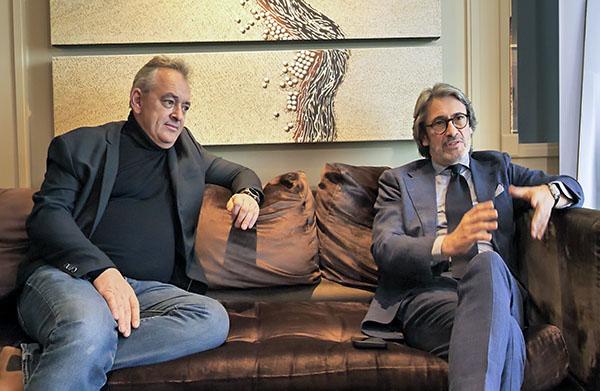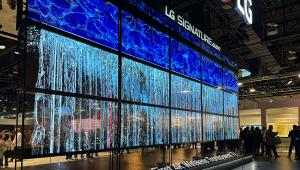Interview: Focal Aria Evo X Speakers

Joining me are Cedrick Boutonet—CEO of Vervent Audio Group, overseeing both Focal and Naim, and Arnaud Hendoux—managing director for Americas at Vervent Audio Group. We discuss the strategic importance of in-house speaker development and manufacturing, a cornerstone of Focal's identity and success.

Focal's dedication to producing its own components, from membranes to drivers, has been a key factor in their ability to deliver excellent sound quality. This hands-on approach to engineering and design allows for designs with minimal electrical correction in their speakers.
With the audio industry undergoing a significant shift towards active speakers and immersive audio solutions like Dolby Atmos, Focal remains at the forefront of speaker design and technology. Here's how.
Mark Henninger: Here we are at CES 2024, you've got a new line, Aria Evo X, and what I want to know is how you arrived at Aria Evo X and how Focal's approach to high-end audio manufacturing has evolved over four decades and brought us here.
Cedrick Boutonet: In the last four decades, I would say that the brand journey has been quite simple. The aim is to deliver the best performance in sound and deliver the promise, the high-end fidelity. So, we're lucky that we have in our factory, in our facilities, the chance to develop our own speakers and to develop our own membrane, and Aria Evo is the right evolution and the right example of what the group is able to achieve.
MH: So that's a key strategy, is to have the in-house capability to produce the speaker that you envision or want.
CB: The full control, I would say.
Arnaud Hendoux: It's a big part of our DNA. Without this, it won't be Focal.
MH: I know that Focal concentrates on certain specific technologies to achieve this in terms of the tweeter design and materials as well. Can you speak to that a little bit?
CB: What is very important for us is that we develop internally not only the materials, but also all the techniques and also the tools in order to control the full process—the full production process—which gives us a very strong advantage compared to our major competitors.
AH: I don't want to go too deep in terms of technology, but one other part of the DNA of Focal is that we are not making any electrical correction on our speakers. As we are able to start and to build our own speakers from the membrane to the spider to all parts, we are able to produce exactly what we want in terms of sound. So it means that we don't need to have the big crossover on the back of the speakers. This is the main difference between Focal and the other ones.
MH: This I can understand very well, because in my youth, I used to have, when I was a kid, I had EPI speakers, and that was based on the idea of a module that just needed one resistor. So having less components in the crossover, that's a good thing, because otherwise you basically have to burn off the electricity to get the response where you want it to be.
So that would represent just a particular technological approach now to design. Is there any emerging technology that plays a significant role in producing speakers in this manner?
CB: In fact, the hardware industry is in front of a big shift in terms of technology. We're talking about disruption, because we're moving from passive system to active speakers, and also from two-channel to immersive solutions, thanks to a new standard which is coming up on the market, which is Dolby Atmos in audio. Of course, we have to stick to it.
Another very important point is that if we want to make sure that we get some point of interest from the market at large, we must make sure that our devices, our product, are compatible with ecosystems or technology which are not native to our industry. So we must be compatible with other people, other companies like Amazon, like Apple, like Google, et cetera. So of course, it has a huge impact on the way we develop the product.
MH: So going active means there's IP in there, there's connectivity—just by default because it's an expectation. But I would also imagine that in an active speaker, you still maintain the benefits of designing the drivers in the manner that you do, because then you have to use less digital EQ.
CB: Not only that, but also we have the chance to have two companies in the group which are complementary. So of course, we're going to implement the best electronics you can find on the market, which is Naim, in our beautiful speakers.
MH: So a synergy there as well, from an engineering perspective, you would consider that all to be in-house.
AH: In the meantime, you must keep in mind, too, that you have three verticals at Focal, where we have the Pro Audio, the Car Audio, and the Home Audio. So we are able to take the best thing from each one in order to provide the best result and after to implement on the other verticals.
CB: We are talking about cross-strategy and cross-technology.
MH: Certainly. Yes, I've always respected the fact that you create monitors and that therefore that's the starting point. I talk to people about the idea of what aspect of a performance can you reproduce musically, and the reality is what you can reproduce is the moment where it was mixed and mastered. You can't go past that. But you can certainly get as close, or in some aspects even exceed it, just in terms of the dynamics that those speakers are capable of. So there's a real connection there in terms of the technology, in terms of how the speakers are voiced and what your ultimate goal is to create that transparent sound.
CB: Yep.
AH: Yep.
MH: What are the biggest challenges today in creating high-fidelity audio equipment?
CB: First, I would say that we've been going through a very difficult journey on the last few years because the market was very unstable. And from a macro vision, macro perspective, the overall context was not that good. Nevertheless, the group and my team find solutions to grow the business and to develop new product, which is key. So I do believe that we're still on track, and we have the resources, the capabilities to develop a new standard for the market.
MH: As a CEO, what personal philosophies are you bringing to this leadership and this direction in solving these challenges?
CB: What we try to do because, and this is the beauty out of our group, we have two brands, one British, one French, one is specialist of electronics, high-end electronics. The other one is an expert in electro-acoustics. And it's also sort of right balance mix between technology and know-how, savoir-faire. And it's also the right mix between innovation and tradition.
So we are very picky when it comes to the art of the execution and the way we monitor those synergies and also this balance between our brands. We are very, very careful on the art of the execution.
AH: The best example is, as you said, the Aria EvoX, which is a brand-new speaker, which we are launching 10 years later, the first Aria. And all the people who already listen it since today now say, oh, are you still able to increase the quality of the sound? Every time we are saying that when Focal is launching a brand-new speaker, the sound is better than the previous one. Fortunately, we are able to succeed on it and to upgrade and to increase the quality of the tone every time.
MH: Obviously, the core of any speaker is its performance. But can I also ask you what the influence of aesthetics is on the market today? Because I've certainly seen the word colorways appearing and I've seen some very special finishes on some of your speakers. Can you tell me where that fits in?
CB: So it's very important because our industry is changing. If we rely only on audiophile customers, it's a shrinking market. It's in evidence. But we have the chance to rely also and to have in our skill set—in our portfolio—some traditional know-how so we can develop special finishes. Nowadays, the design language is very important at Focal. If you look at the headphone portfolio, you will see that there is some consistency in terms of design language.
It's the same thing when it comes to the loudspeaker. And we are very careful, very picky when it comes to this kind of thing. So in terms of brand platform, we made some strong improvements in the last few years. And what we try to do, because we know that the one-size-fits-all approach doesn't apply anymore, we want to make sure that we develop products for specific customers. So it's all about the micro-segmentation. And it fits also with our vision and with our strategy, which is to have a global approach, so a global vision and a local implementation. That's why we tend to develop some specific products for different distribution networks and also different markets.
AH: We are able today to do some bespoke products and even to have some pieces of art, which are doing music. That's the reason why this year we opened and we launched the Focal Foundation. It's a big part. It's a part of the complete strategy where we want to go for the future.
Find out more about the Aria Evo X line in this product tour and demo video from CES 2024.














































